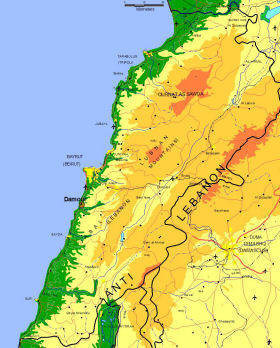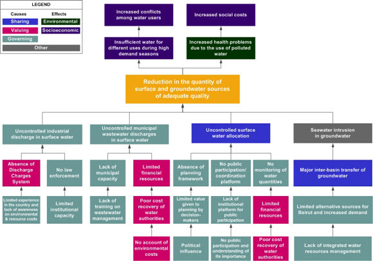In this issue:
The INECO
Approach in IWRM
Overview of the INECO Case Studies
Problem Analysis in the Damour River Basin, Lebanon
Major INECO events during the first year of the project
INECO Stakeholder workshop in Tunisia
Stakeholder consultation in Lebanon
The Egypt Women Awareness Symposium
The 1st semester Deliverables of INECO
Future
project events
The INECO Consortium |
Problem analysis in the Damour Basin, Lebanon
|
|
Damour is a coastal village located
20 km south of Beirut. The population of
the area is around 75,000 inhabitants.
The area is an important crossroad,
linking Beirut to the Shouf Caza in the
Mount Lebanon, and to other southern
cities and villages such as Saida, Tyr
and Nabatiyeh. The village relies on
both groundwater (public and private
wells) and surface water resources.
The main
water management issue
experienced in the Damour River
Basin is
related to the sustainability
and availability of water, both
in terms of quality and
quantity, and mostly during the
summer. The short period of
precipitation and the torrential
flow of the Damour River
influence the disparity in water
availability. In order to
resolve this problem, both water
authorities and private users
turn to the overexploitation of
the coastal aquifer, which
further incurs:
-
Overexploitation and
pollution of the Damour
River,
-
Overexploitation of the
public wells of the Beirut
Water Authority (BWA),
-
Overexploitation of private
wells in the Saadiyat Area,
and
-
Water losses in distribution
networks and improper
irrigation practices.
All the above problems are aggravated by the absence
of legislation for the management and monitoring of
both surface and groundwater resources in the
village and the basin as a whole, and the lack of
awareness among the community to prevent or mitigate
environmental deterioration. |

Financial issues can be summarized in the inadequate
cost recovery for water supply provision, as water
supply agencies can barely recover their operating
expenses. On the other hand, the administrative and
institutional framework is, in its majority,
outdated and the legal structure suffers from
overlaps. Political intervention in the attempts to
recruit personnel seems to add more burden on water
resources management.
|
|
|
|
The focal water management problem faced in the
Damour River Basin is the decrease in the total
amount of surface and groundwater of adequate
quality required for meeting the water needs of
domestic, agricultural and industrial users (water
stress). The problem is particularly experienced in the
downstream irrigated coastal plains of Damour, where
farmers complain about the shortage of water during
the summer season, as water is abstracted upstream
and there are no rules governing water allocation.
Groundwater resources are also under stress due to
the significant abstractions, especially for
inter-basin transfer. The Damour municipality has
repeatedly expressed its concern about the increased
salinity of groundwater. A more detailed analysis of
the problem is presented in the Figure below. The focal problem is caused by several
factors including uncontrolled discharges of industrial and
domestic wastewater in surface water, uncontrolled surface
water allocation, and seawater intrusion in groundwater.
|
These are in turn attributed to
limited law enforcement, inadequate regulatory
instruments, limited capacities of authorities
(particularly for law enforcement), limited
financial resources, absence of a clear planning
framework, absence of a participation and
coordination platform, and limited monitoring
activities. Inter-basin transfer of groundwater resources is
leading to deterioration of groundwater quality in
the coastal area. These issues are further caused by
lack of relevant awareness and technical capacity,
by social and political pressure from user groups,
and lack of integrated management of the water
resources of the area. It is expected that the focal problem could further
lead to an increased number of conflicts among water
users, and to increased social costs incurred from
health problems associated with the use of polluted
water. |

Preliminary Problem Tree
Analysis for the focal problem of
the Damour Basin, Lebanon
(Click here to enlarge) |
Current institutional arrangements and the
way the problem is being addressed
|
|
The main authority responsible for the management of
water resources in the Damour River Basin is the
Ministry of Energy and Water (MoEW). MoEW is
responsible for setting the planning framework for
sustainable water management with the river basin.
MoEW has planned to construct a major dam within the
river in order to reduce the losses of water to the
sea during the rainy season, but the project has not
yet been implemented. While the Council for
Development and Reconstruction (CDR) could play a
role in mobilizing resources for the execution of
such projects, no progress has been
made so far.
The Beirut and Mount Lebanon Water and Wastewater
Establishment (BMLWWE) is responsible for supplying
potable water to its subscribers. While the Damour
Basin falls within its jurisdiction, groundwater
from Damour is pumped to supply water to Beirut but
apparently without adequate consideration of safe
yields since groundwater salinity has been
increasing indicating possibility of seawater
intrusion.
|
The
Ministry of Environment (MoE) is the authority
responsible for controlling sources of pollution;
however at present it has limited capacity to
monitor the numerous environmental violations within
the basin. The Ministry of Public Health (MPH) also
monitors the safety of drinking water. The same
applies for local municipalities. In addition, the Damour municipality operates groundwater wells to
supply potable water to the Damour village.
Unfortunately, limited efforts towards a more
sustainable use of water resources in the basin are
witnessed. This is largely due to the lack of
coordination and cooperation among the different
responsible agencies. While limited action is
undertaken to remedy the problem, users continue to
exploit the resources in an uncontrolled manner and
environmental violations are still occurring within the basin.
|
Lessons from past experience
|
|
Previous initiatives in different river basins have
been undertaken to promote integrated water
resources management. The CAMP project, financed by
the United Nations Environment Program (UNEP) and
the Mediterranean Action Plan (MAP), and managed by
the Priorities Action Program Regional Activity
Center (PAP/RAC), was implemented in Lebanon by the
Ministry of Environment from 2002 to 2004. It aimed
at promoting integrated coastal zone management and
has promoted specific interventions at three coastal
cities, namely Damour, Sarafand and Naqoura.
Although the project successfully mobilized local
communities in integrated water resources management
and other sustainable practices, it has failed to
ensure continuity of activities. This was partly due to
the fact that no follow-up activities have yet been launched by the
MoE, the authority responsible for project implementation.
|
Another important initiative was
the one financed by
the Japan International Cooperation Agency (JICA),
which aimed at the development of a water resources
master plan for Lebanon, under the coordination of
MoEW. The project started in 2004, but was cancelled
by the MoEW, before the JICA team finalized its work.
It appears that the consultants have not worked in
close cooperation with the main beneficiary, and results of the
assessment were found unacceptable. This was also largely due to the
highly political nature of
water management in the region.
The EC-financed IPP-MSC project, aiming at
strengthening the institutional structure of the
MoEW and the water and wastewater establishments
can, on the other hand, be considered a
successful water management initiative. It was able to build capacity
in beneficiary institutions,
developed a decision-support tool that would be used
for planning, and provided training to the
corresponding staff. However, the project did not
target
the development of specific river basin management
plans that could be used for guidance in the case
of Damour.
|
|

|
|



